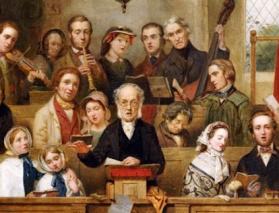In his book, Wiser than Despair , Quentin Faulkner traces the links between musical theory (musical speculation) and theological speculation. John Scotus Erigena’s views, for instance, were summarized by his pupil Regino of Prum, who wrote on music in a treatise on harmony, and the treatise has theological overtones throughout (not entirely biblical, some deriving from Plotinus).
As summarized by Regino, there are two levels of music: “Natural music is that which is made by no instruments nor by the touch of fingers, nor by any touch or instigation of man: it is modulated by nature alone under divine inspiration, teaching the sweet modes, such as there is in the motion of the sky or in the human voice.” Artificial music, however, is music invented by human art and genius.
The pathway to the natural music was through the artificial: “to anyone wishing to have a knowledge of that art, it must be known that, though natural music is far superior to artificial music, no one can know the power of natural music except by the study of the artificial. That is why no matter how much the learned discussion of our argument begins with the natural, we must end with the artificial, so that we can prove things invisible by things visible.” This is the same move that we saw in Origen. Knowledge of spiritual things comes through the agency of knowing earthly things.
Beyond Boethius, however, Erigena and his disciples thought that natural music was the kind sung in the liturgy. This “established that the method by which the church ordered its music here on earth was a reflection of divine order, of cosmic harmony – the rules governing church music practice proceeded from the mind of God.”
Erigena himself: “the beauty of the whole universe is arranged according to an extraordinary harmony of things similar and dissimilar; it is coupled from diverse genera and forms, from different orders of substances and accidents into a certain indescribable unity. Just as the melody of organum consists of diverse qualities and quantities of sounds which, when heard separately, sound largely out of tune with themselves because they rise and fall in separate proportions, but, when heard together in singular modes according to the rational rules of musical art, they render a certain natural charm; so the harmony of the universe is wedded together into a whole as subdivisions of nature are brought in accordance with the will of the creator, but these subdivisions seem to disagree with each other when examined individually.” Faulkner says that this “may be one of the earliest references to polyphony.”











